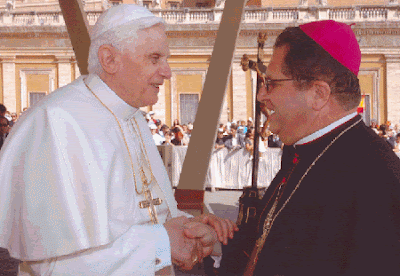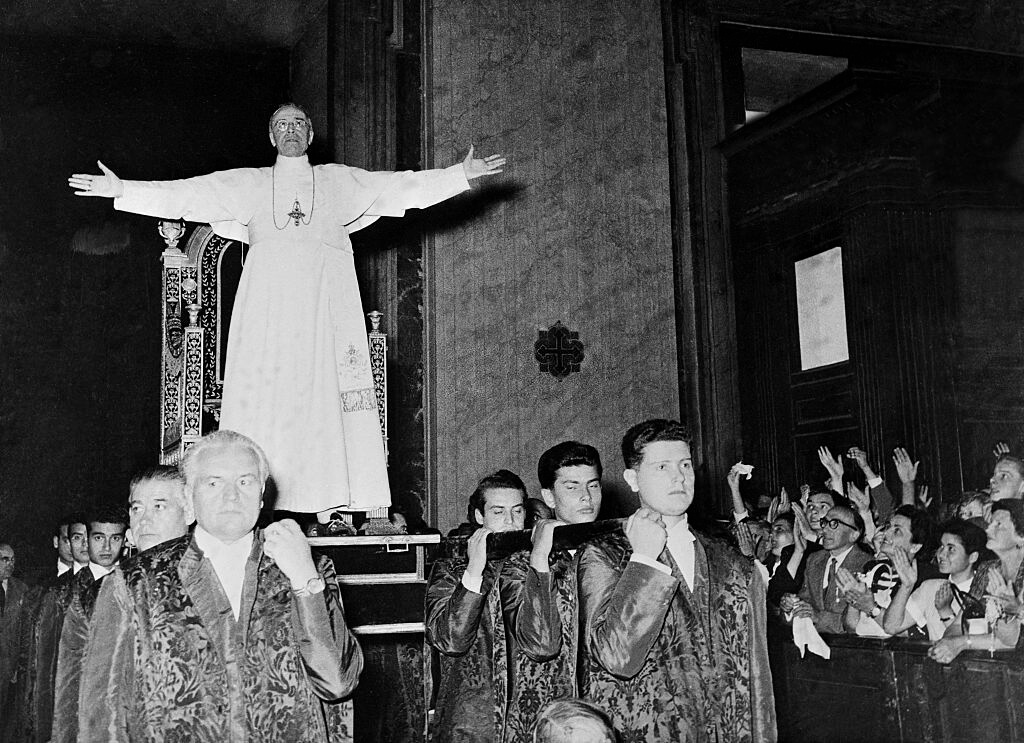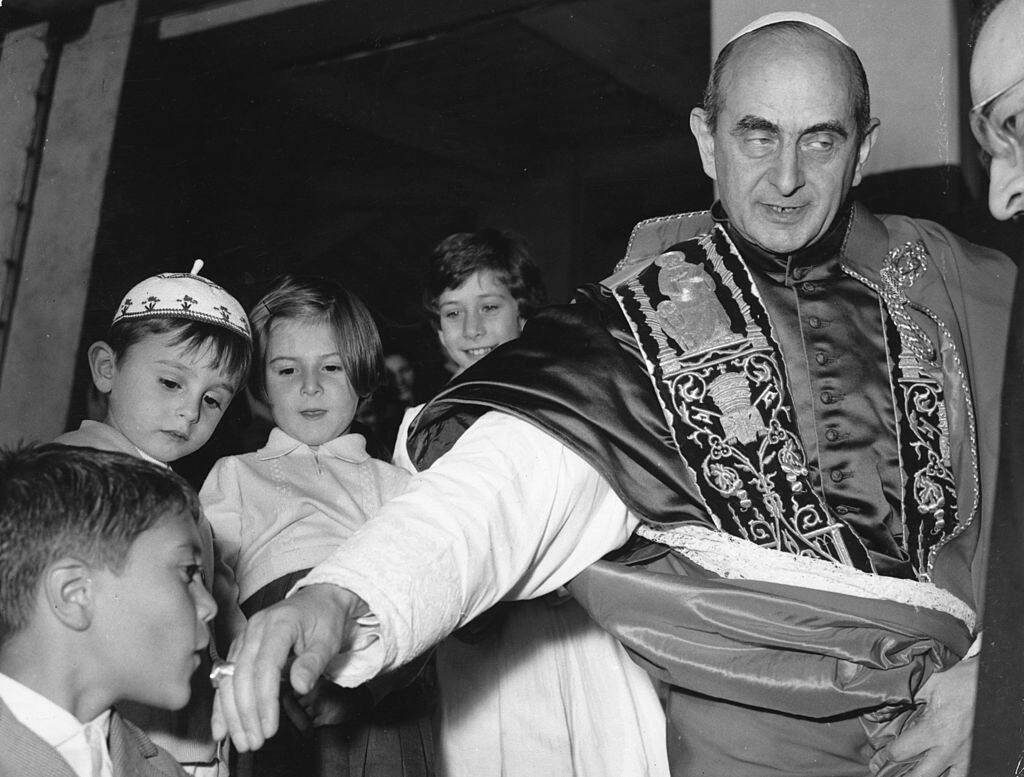Translator’s Preface: The following book review, which appeared in German at kathnews.de on January 4, 2022, is illuminating for many reasons. In describing the oddity of a new (but not updated) German translation of a book written by Bishop Rifan of Campos around the year 2006, the author, Clemens Victor Oldendorf, paints a portrait of the serious internal flaws of the “hermeneutic of continuity” school, which still wishes to pretend—even after nearly a decade of Pope Francis—that some kind of Hegelian synthesis of preconciliar and postconciliar remains possible, and that it is an all-powerful papacy that will be the instrument of its accomplishment. One wonders what it would take to awaken such people from their pleasant dreams.
More urgently, one wonders how soon Bishop Rifan and the clergy of Campos will be asked to “accompany” their flocks to the so-called “only expression of the lex orandi of the Roman Rite.” Sustained by a theology as poor as the bishop’s, Campos will fall like a house of cards in a brisk wind. Moreover, Bishop Rifan turns 75 in four years. Unless something changes dramatically in Rome, Campos may not see a successor consecrated according to the old pontifical, nor a man who is of the same mind as Rifan about the value of the authentic lex orandi of the Roman Church. The version of the review presented here, which differs in some respects from the German original, has received approval in forma specifica from the author.—Dr. Kwasniewski
Multiple Rolls Backward[1]
A Review of Bishop Rifan’s Tradition and Living Magisterium
By Clemens Victor Oldendorf
It is rather difficult to understand the motives that induced the Renovamen publishing house to present the book Tradition and Living Magisterium at the end of last year [2021], of all times, as a new publication, namely, the German translation [Tradition und lebendiges Lehramt] of a text whose Portuguese original—as can be concluded from internal criteria—must have appeared around 2006.[2] Its author is Bishop Fernando Rifan, who presides as Ordinary of the Apostolic Administration of the Holy Curé of Ars, whose territory coincides with that of the Brazilian diocese of Campos, and to whom the liturgical books of the Roman Rite as it was in force in 1962 (according to Traditionis Custodes, we must be formally correct and precise) were granted as a proper rite.
Apart from a new preface by the German Cardinal Gerhard Müller and an addendum on Traditionis Custodes spanning not even three pages, no updating of the text has been attempted.
Thus, at its best, the book is a testimony and document of the mood and expectations of conservative and traditionalist circles in the phase of the beginning of the Ratzinger pontificate (that was a long time ago…). Three examples may illustrate this: on page 20, there is talk of Pope Benedict XVI having “just” given “worldwide freedom to the traditional form of celebrating Mass” with Summorum Pontificum, while in fact it is Pope Francis who has just taken back this freedom worldwide with Traditionis Custodes. Referring to the 1990 Instruction Donum Veritatis, page 42 states that it “recently recalled” the need for a fundamental loyalty to the Magisterium. If one did not know that Cardinal Ranjith has been Archbishop of Colombo since the summer of 2009 and, by the way, opportunistically has long since discontinued—or, at least, no longer articulates—any commitment in favor of the traditional liturgy or of a tradition-oriented ars celebrandi in postconciliar worship, one would think after reading (p. 54) that he had “recently” been appointed Secretary of the Congregation for Divine Worship. However, that was the case on December 10, 2006.
It is a great shortcoming in a publication if such things are not updated and left unremarked on in a translation of whatever book that is so much delayed. What is frequently done in other contexts could have been done here, too: the translator might at least have included supplementary footnotes to indicate the changed circumstances.

Anachronistic in several respects
These more external weaknesses of the German version, however, do not constitute the most serious deficiency of Tradition and the Living Magisterium. For not only does it give the impression that one continues to be in a climate of hope for a “reform of the reform” or for the hermeneutics of “reform in continuity” in the interpretation of the Second Vatican Council, as presented by Benedict XVI at the Christmas audience on 22 December 2005 to the cardinals—no, even the most positive optimist sees by now that these approaches were never concretely and effectively implemented even during the past pontificate of Benedict XVI and are now, in the area of liturgy since (at the latest) Traditionis Custodes, unmistakably erased.
Correct perceptions and arguments
This is not to say that every argument or observation of Bishop Rifan is false or mistaken. For example, there is undoubtedly still a traditionalist tendency to want to surpass one another in holding a stricter or more extreme position, or in taking up an ever-older version of the Tridentine rite. Likewise, there is a real danger of radicalization and embitterment that can go so far as to occasion the abandonment of any practice of the Faith or even the loss of the Faith altogether. However, it is questionable whether one can, as Rifan does, accuse anyone who, for example, holds or considers the position of sedevacantism or sedeprivationism as a possible theological position (Rifan does not differentiate between the two variants) of being extreme or radical simply on this account.
Sedevacantism is a theological theory and opinion that differs from the present opinion of Bishop Rifan and from, for example, the opinion of the Priestly Fraternity of St. Peter, and, on the other hand, also differs from the position of the Priestly Fraternity of St. Pius X. It is a different position, a different attempt to understand, explain, and deal with on a day-to-day basis the enormous problem of the postconciliar crisis that has existed since Vatican II—a crisis all Catholic traditionalists agree to exist; an attempt, we may say, to solve it above all in practical terms. Sedevacantism and sedeprivationism are thus not automatically extreme or fanatical, and there are some theologians, especially in the USA, who hold these positions in an objective, moderate, and even conciliatory manner, without any danger of embitterment. It is not my purpose here to either endorse or critique such views.

Only the conclusions differ
Rather, I emphasize the point for the reason that Bishop Rifan conspicuously advocates the same magisterial positivism and follows the same ultramontanist narrowing of a certain current of nineteenth-century neoscholastic theology that remained a guiding force in Rome until about the middle of the last century and because of which the sedevacantists, by following it out in a particularly stringent manner, reach their conclusions. While the sedes think that, because of their ultramontanist presuppositions, the post-conciliar popes could not be legitimate popes or, in any case, could not exercise the authority of a legitimate pope in an effective and binding way, Bishop Rifan, with a certain over-extension or almost apotheosis of the pope (as was not unusual in the nineteenth century) thinks that the postconciliar popes are legitimate. And thus, because they are popes, he thinks there can be nothing to object to in the Second Vatican Council and in the postconciliar magisterium as well as in the liturgical reform of Paul VI.
In this sense, Rifan approvingly and exclusively quotes preconciliar theologians up to the immediate eve of the Second Vatican Council, who, however, obviously do not know and are not engaging with the nature and extent of Paul VI’s postconciliar liturgical reform and, possibly due to ultramontanist bias, could never have imagined a development initiated and authorized by the Pope such as the one that took place during and after Vatican II. On the basis of experience since then, it is clear how important it is to understand not only the jurisdictional primacy of the pope but also his personal, individual infallibility in the context of the larger tradition and theological endeavor that preceded the First Vatican Council for centuries and not just in the immediate run-up to it. This point must be made, of course, in response not only to Rifan, but to many others who, with sometimes quite contradictory consequences, tend to take refuge in a supposedly ideal world of the pontificates of Pius XII or Pius X.
Why was and is the traditional liturgy adhered to at all?
Another weakness of such formalistic, positivistic argumentation as presented by Rifan is that it ignores the fact that the Roman Liturgy, in the form given to it by Paul VI, is not usually celebrated on the basis of its editio typica—and not even in this case, in its Latin version, at a high altar, with male altar servers and the classical form of receiving Communion, would the “renewed” rite of Mass be flawless. Moreover, the liturgy that actually exists out in the world is very different from what might be called the “theoretical liturgy” of Paul VI. Such a discrepancy never existed with regard to the preconciliar liturgical books that the preconciliar voices to whom Rifan refers had taken for their object of reflection, and whose judgment he now simply transfers to Paul VI’s liturgical reform of 1969.
Incidentally, if the author were truly consistent, he would have to concede that there was consequently no room to privilege the old liturgy or to retain it on the basis of a preference. In that case, he should have long since moved his Apostolic Administration to adopt, after all, the editiones typicae of the postconciliar liturgical books (even if we might say, for the sake of argument, in their most conservative interpretation and employment in worship). And anyone who agrees or does not strongly disagree with Rifan’s papalist reasoning would also have to accept the same conclusion for himself.
Actually, he would have to open himself up even further if he were to agree with Cardinal Müller, who writes in the Preface: “To a genuinely Catholic mind, it must seem absurd that a dispute over dogmatic truth should be ignited by the two forms of the one Mass, which differ only in some external rites, including the direction of celebration and the language of celebration in Latin or the vernacular, which do not belong to their substance.”
This preface was already out of date when it was penned on 4 November 2021, because, according to Traditionis Custodes, there are no longer two forms of the Roman Rite, and, before Summorum Pontificum, there were many variants of Gregorian-Latin liturgy in the Western Church, but not an “ordinary” and an “extraordinary” use of the Roman Rite that differed as much from each other as the Roman Tridentine on the one hand and the postconciliar Pauline Rite on the other, the latter of which is now established by positivism as the sole expression of the lex orandi in the Roman Rite.

An abstract-theoretical interpretation of the Council as a form of denial of reality
Bishop Rifan is similarly out of touch with reality, not only in his almost compulsive pressure to justify himself with regard to the postconciliar liturgical reform—from which, however, his Apostolic Administration has so far remained exempt in principle—but also in his handling of the texts of the Second Vatican Council. What is the use, one might ask, even if a hermeneutic of continuity is possible in many cases and is (or was) supported here and there with documents by the Magisterium, when in reality (as Rifan says) “the ecclesiastical public has allowed itself to be impressed in part [recte: dominantly] by modernist interpretations or Protestant expressions of opinion” and when these interpretations continue to be the ones that practically prevail? It doesn’t seem to have much more use than a theoretical rite of Paul VI, as we have sketched it above, when it barely exists anywhere—and which, moreover, would only hide for a time the losses and deficiencies that are still inherent in it, compared to the Gregorian rite codified after the Council of Trent.[3]
A single positive aspect of the book and a possible positive effect
Of course, the Magisterium is alive (inasmuch as those who can wield it are alive), and one advantage of the book presented here, albeit very critically, is when it speaks in its title of a “living Magisterium”[4] and not of “the living character of Tradition.”[5] The Tradition has stability and those who exercise the Magisterium can fail in their non-definitive judgments. Thus, anyone who recognizes the incumbent popes and bishops as legitimate can, in principle, strongly criticize what they have taught and decreed from a certain point in time, and basically fade it out or ignore it for himself and his environment.[6]
Yet if Bishop Rifan were right, any traditionalist reaction to the Second Vatican Council and especially to the new rite of Mass of 1969 would have been illegitimate from the beginning. Indeed, the occurrence of such a crisis as the traditionalists perceive would have been excluded from the outset by the assistance of the Holy Spirit.
That nearly nothing is excluded and impossible in the Church can be seen now (at the latest) with Pope Francis and Traditionis Custodes; after all, the pope with his motu proprio simply endeavors to return us to the original situation immediately after Vatican II and after the introduction of the Pauline Novus Ordo Missae.
If the book Tradition and the Living Magisterium, in the form in which it is presented in a German translation at the present moment, is to have any meaning at all for the Church and to be of any use, it is the realization that rolling backwards accomplishes nothing. One can neither remain mentally in the pontificate of Benedict XVI and in the projections and hopes that were not fulfilled in that pontificate, nor roll backwards into the immediate post-conciliar period with all that Pope Francis wants to do and prescribe, since the exaggerated magisterial and papal optimism characteristic of Paul VI’s era was only a rather short-term phase and tendency, already breaking down in his day, and all the more in ours.
The experience of the immediate postconciliar period and the adherence that spontaneously arose especially for the liturgical tradition under attack intuitively proved, already at that time, that this ultramontanist current is inapplicable and unable to carry on the tradition. This hard-won insight remains valid now and in the future. Possibly it even becomes clearer thanks to the contrast of Bishop Rifan’s naïve remarks; otherwise, the reading of his book would be dispensable, given how weak and disappointing was its statement on Traditionis Custodes.
Photo by Girl with red hat on Unsplash
[1] The author is referring to a gymnastic exercise in which, instead of rolling or tumbling forward as is usual, the gymnast does it backward. It thus serves as an image of trying to go back to a former state of affairs—as in the expression “turning back the clock.”
[2] The publication year for the German first print run is 2022, but the book was actually delivered at the end of 2021.
[3] It would also be consistent here to distinguish the original somewhat moderate liturgical form up until 1965 from the subsequent, more radical Pauline form issued in 1969.
[4] Bishop Rifan also correctly refers here to the Second Vatican Council and Dei Verbum 10, cf. Rifan, Tradition und lebendiges Lehramt, p. 33, note 19.
[5] As occurred, spinning the Council text further, in the Motu Proprio Ecclesia Dei, where in 4 and 5b there are unsustainable references to Dei Verbum 8.
[6] Cf. the well-chosen contrast between a “signpost” and a “companion,” Tradition und lebendiges Lehramt, pp. 27f.


